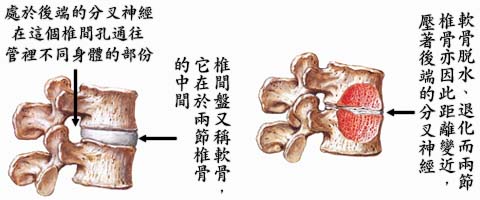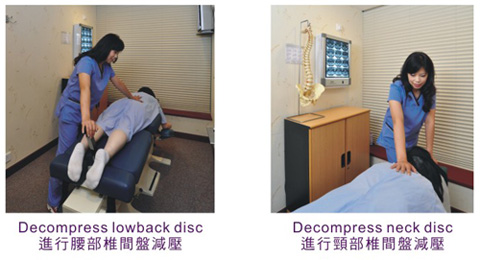
2013-11-18

What is Herniated Lumbar Intervertebral Disc?
Disc herniation is one of the causes of low back pain or sciatica. It not only causes restlessness, back pain, and numbness of the feet, but also makes people unable to work and having normal activity.

The intervertebral disc is located between the upper and lower vertebrae, and is composed of the inner layer of nucleus (gel) and the outer layer of fibrous ring. The function of the intervertebral disc is to absorb the pressure on the spine, and also has the effect of shock absorption. When we move the body and bend forward or backward, the disc also takes different shapes to cope with the body’s movements. However, as the body continue to bear weight, the nucleus pulposus will begin to become dehydrated and deteriorated, the ability to absorb stress will also decrease, and the fibrous annulus will begin to degenerate at the same time. Improper postures or movements, may also cause herniated disc.

Herniated Lumbar Intervertebral Disc
When the intervertebral disc of the lumbar spine is herniated, (depending on the disc protrusion), the patient will feel pain in the lower back or from the back to the buttocks, thighs (lateral or medial side), calves (posterior, anterior lateral or anterior medial). The back of the foot and soles will feel numb, and the pain increases when coughing, sneezing, bending over or holding heavy objects. Patients may also find it difficult to stand or walk, they tend to tilt their body sideways. In severe cases, they may feel restless and even have back pain with bed rest. In addition to pain and numbness, they may also cause weakness or atrophy of lower limbs.

Lumbar disc herniation is most common between the fourth and fifth vertebrae, followed by the fifth lumbar vertebrae and the first vertebrae of sacrum, and may also occur between the third and fourth vertebrae. From the patient’s condition alone, neurological analysis can generally confirm that the patient’s disc is herniated. However, due to some other diseases of the spine such as lumbar degeneration, spine or spinal cord tumors, spinal canal stenosis may cause symptoms similar to herniated discs.
Therefore, every patient diagnosed with intervertebral disc herniation must undergo MRI scan of the lumbar spine to rule out the possibility of other diseases. The diagnosis rate ranges from 85% to 90%. Magnetic Resonance scan is a safe scan, there is no radiation, and it can be done in MRI centre ( www.accurate-mri.com)
Herniated Lumbar Invertebral Disc
Patients suffering from intervertebral disc herniation and intervertebral disc prolapse are quite severe due to the high intensity of pain and numbness. In many cases, the first reaction of the patient is to take painkillers and anti-inflammatory drugs, or take painkillers to relieve pain. But often after the medication, the pain still persists, because the disc is still presses the nerve. Of course, if the patient’s pain is really unbearable, painkillers are still needed.
To effectively treat the herniated intervertebral disc protrusion, we must first reduce the internal pressure of the disc, and manage in many lifestyle habits (such as incorrect posture) and gradually recover with treatment.
70-80% of patients can treat intervertebral disc herniation without surgery
To treat intervertebral disc herniation, continued therapy (non-invasive treatment, such as chiropractic therapy) should be used first, and 70-80% of patients can be cured without surgery. If the patient’s condition has not improved or worsened after approximately 3 months of treatment, or the patient has severe neurological disorders such as loss of muscle strength, bladder or stool incontinence , or repeated episodes of pain in the patient, it becomes more frequent and severely increased. surgery may be required.
Another relatively treatment method is “chemo nucleolysis" (chemo nucleolysis). Under X-ray fluoroscopy, papaya enzyme is injected into the diseased intervertebral disc via subcutaneous injection to dissolve the nucleus pulposus and reduce the pressure of the intervertebral disc to achieve the therapeutic effect. However, papaya enzyme has the side effects of causing anaphylactic shock and myelitis (severely can cause paralysis of the lower half of the body), and it is only suitable for the treatment of some mild disc herniation.
COX® Decompression Manipulation -Correcting the spine without relying on painkillers to relieve pain
Chiropractors will use ice compress, eletrode therapy, Cox® therapy and manual therapy to treat the protruding disc and help the patient relax muscles and relieve pain. The treatment period is generally longer, about 2-3 months, depending on the severity of the patient.
“Cox® Decompression Manipulation". Cox® treatment was invented by Dr. James M. Cox in the United States in 1960. He used two different techniques, “traction" and “decompression" to control the movement of the spine. The founder of the clinic.
Cox® Decompression Manipulation is particularly effective in reducing the symptoms of back pain, foot pain, neck and shoulder pain. It is especially significant for spinal pain caused by intervertebral disc protrusion, sciatica, spinal stenosis, and spondylolisthesis.
Cox® Decompression Manipulation is a treatment method that has passed long-term clinical research and proven evidence, and it is also a treatment method that has been cited in many ways to effectively reduce back pain. It does not rely on invasive treatments such as painkillers and surgery. Compared with other treatments, Cox® Decompression is a relatively mild treatment and highly effective to treat disc herniation.


 Book an Appointment
Book an Appointment


